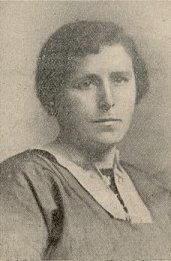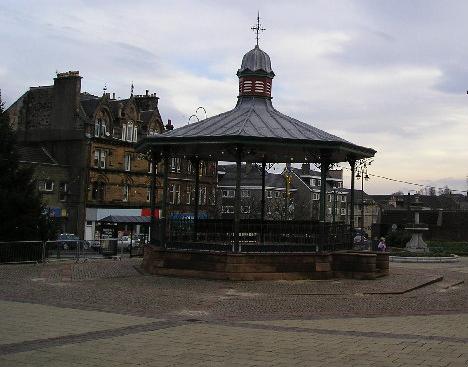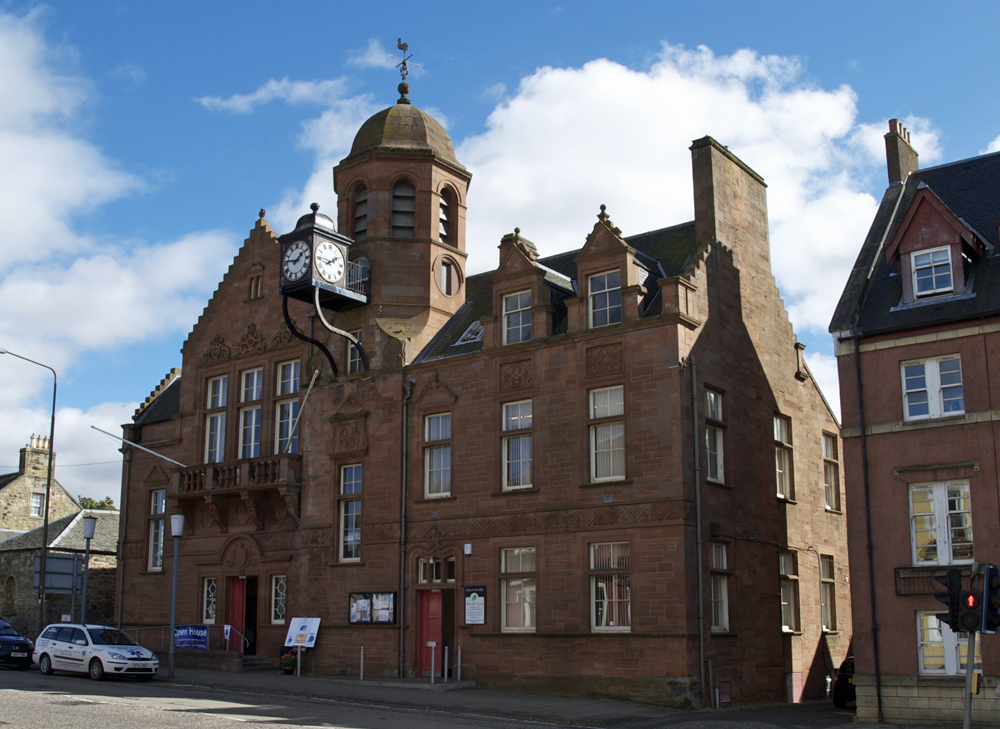|
Kilbarchan
Kilbarchan ( gd, Cill Bhearchain) is a village and civil parish in central Renfrewshire, in the west central Lowlands of Scotland. The village's name means "cell (chapel) of St. Barchan". It is known for its former weaving industry. History The village was once one of many weaving villages, and at one time there were 800 handlooms in the village. The weavers were active in the Radical movement which sought parliamentary reform, and Kilbarchan played a part in the agitation of the so-called Radical War of 1820. One cottage named the "Weavers Cottage" built in 1723 has been conserved by the National Trust for Scotland with weaving still in operation, and guides demonstrate handloom weaving to visitors. Kilbarchan was the birthplace of Mary Barbour, the Scottish political activist who led the Glasgow rent strike of 1915 and later became Glasgow's first woman councillor. Lilias Day The main annual event in the village calendar is the celebration of Lilias Day, on the first Sa ... [...More Info...] [...Related Items...] OR: [Wikipedia] [Google] [Baidu] |
Kilbarchan
Kilbarchan ( gd, Cill Bhearchain) is a village and civil parish in central Renfrewshire, in the west central Lowlands of Scotland. The village's name means "cell (chapel) of St. Barchan". It is known for its former weaving industry. History The village was once one of many weaving villages, and at one time there were 800 handlooms in the village. The weavers were active in the Radical movement which sought parliamentary reform, and Kilbarchan played a part in the agitation of the so-called Radical War of 1820. One cottage named the "Weavers Cottage" built in 1723 has been conserved by the National Trust for Scotland with weaving still in operation, and guides demonstrate handloom weaving to visitors. Kilbarchan was the birthplace of Mary Barbour, the Scottish political activist who led the Glasgow rent strike of 1915 and later became Glasgow's first woman councillor. Lilias Day The main annual event in the village calendar is the celebration of Lilias Day, on the first Sa ... [...More Info...] [...Related Items...] OR: [Wikipedia] [Google] [Baidu] |
Mary Barbour
Mary Barbour ( Rough; 20 February 1875 – 2 April 1958) was a Scottish political activist, local councillor, bailie and magistrate. Barbour was closely associated with the Red Clydeside movement in the early 20th century and especially for her role as the main organiser of the women of Govan who took part in the rent strikes of 1915.Audrey Canning, ‘Barbour , Mary (1875–1958)’, Oxford Dictionary of National Biography, Oxford University Press, 2004; online edn, May 200accessed 14 Feb 2014/ref> Life Barbour was born on 20 February 1875 at 37 New Street, Kilbarchan to Jean (Gavin) and James Rough, a handloom carpet weaver. She was the third of seven children. Barbour attended school until she was fourteen years old. In 1887, the family moved to the village of Elderslie and Barbour worked as a thread twister, eventually becoming a carpet printer. On 28 August 1896, Mary Rough married an engineer, David Barbour (2 May 1873 – 13 November 1957), at Wallace Place, Elderslie. ... [...More Info...] [...Related Items...] OR: [Wikipedia] [Google] [Baidu] |
Habbie Simpson
Habbie Simpson (1550–1620) was the town piper in the Scottish village of Kilbarchan in Renfrewshire. Today Simpson is chiefly known as the subject of the poem the ''Lament for Habbie Simpson'' (also known as ''The life and death of the piper of Kilbarchan''). Inhabitants of Kilbarchan are informally known as "Habbies" to this day. The ''Lament for Habbie Simpson'', written by Robert Sempill the younger, was the first notable poem written in the form known as "standard Habbie", or Burns stanza. The Burns stanza was widely used by Burns and Robert Fergusson Robert Fergusson (5 September 1750 – 16 October 1774) was a Scottish poet. After formal education at the University of St Andrews, Fergusson led a bohemian life in Edinburgh, the city of his birth, then at the height of intellectual and c ... in their poems. Kilbarchan's Steeple Building has an exterior niche which contains a statue of Simpson. The original statue was carved in wood by Archibald Robertson of Gre ... [...More Info...] [...Related Items...] OR: [Wikipedia] [Google] [Baidu] |
Kilbarchan Railway Station
Kilbarchan railway station was a railway station serving the village of Kilbarchan, Renfrewshire, Scotland. The station was part of the Dalry and North Johnstone Line on the Glasgow and South Western Railway. History The station opened on 1 June 1905,Butt, p. 131 and closed to passengers on 27 June 1966. The station was originally an island platform covered by an overhanging glass canopy. Access to the station, was via two glazed brick lined entrance ramps at either end of the platform; one leading to the archway under the green bridges in the village's main thoroughfare High Barholm, and the other leading down to a minor road near the Tandlehill estate. When the station was built, several of the cottages in the street had to be cleared to make way for the station entrance, and the bridges over the street.'Lost railway lines south of Glasgow' A. Wham 2000 The station's platform remains partially intact. However, the trackbed is now part of National Cycle Route 7 Route ... [...More Info...] [...Related Items...] OR: [Wikipedia] [Google] [Baidu] |
Renfrewshire
Renfrewshire () ( sco, Renfrewshire; gd, Siorrachd Rinn Friù) is one of the 32 council areas of Scotland. Located in the west central Lowlands, it is one of three council areas contained within the boundaries of the historic county of Renfrewshire, the others being East Renfrewshire to the east and Inverclyde to the west. It also shares borders with Glasgow, North Ayrshire and West Dunbartonshire, and lies on the southern bank of the River Clyde. The term Renfrewshire may also be used to refer to the historic county, also known as the County of Renfrew or Greater Renfrewshire, with origins in the 16th century. The larger Renfrewshire, containing Renfrewshire, Inverclyde and East Renfrewshire, remains in use as a registration county and lieutenancy area as well as a joint valuation board area for electoral registration and local tax valuation purposes. The town of Paisley is the area's main settlement and centre of local government and contains the historic county town, ... [...More Info...] [...Related Items...] OR: [Wikipedia] [Google] [Baidu] |
Johnstone
Johnstone ( sco, Johnstoun, gd, Baile Iain) is a town in the administrative area of and larger historic county of the same name, in the west of |
Campbell Douglas
Archibald Campbell Douglas (usually simply referred to as Campbell Douglas) (14 June 1828 – 14 April 1910) was a Scottish architect based primarily in Glasgow. He designed many churches in Glasgow and Edinburgh, especially those for the Free Church of Scotland. He was three times President of the Glasgow Architectural Association and in 1891 was the Vice President of the Royal Institute of British Architects. He was active in politics, and was a member of the Scottish Liberal Club, Glasgow Liberal Club and National Liberal Club (in London). He was also a Justice of the Peace in Argyllshire.Dictionary of Scottish Architects: Campbell Douglas Early life Douglas was born at Kilbarchan in 1828, the son of Janet Monteath and the Rev. Robert Douglas, minister in the parish of Kilbarchan in Renfrewshire. He attended the University of Glasgow at the age of 13. In 1842, he was articled to John Thomas Rochead, architect, who was based in Glasgow. In 1843, together with his fat ... [...More Info...] [...Related Items...] OR: [Wikipedia] [Google] [Baidu] |
Agnes Lyle
Agnes Lyle or ''Agnes Lile'' (1700s – 1800s) was a British ballad singer who lived in Kilbarchan in Renfrewshire. Her songs which she had learnt from her father were transcribed by William Motherwell and published by Francis James Child. Life Lyle was born to a weaver who lived from about 1731 to about 1811. His name is unknown and Lyle's birth date is only estimated to be about 1775. She is only known because in 1825 she met William Motherwell several times. Motherwell was gathering ballads and he met several Scottish women but Lyle was his best source. She supplied 22 songs and in some cases she gave him the tune and the words. Lyle's neighbours in Kilbarchan supplied other songs. She told Motherwell that she had obtained the songs she sang him from her father. She sang songs of love triangles and patriotic songs but she was said to be cynical about their themes. However when she sang the lyrics of ''Sheath and Knife'' she was moved to tears. The song involves the incestual r ... [...More Info...] [...Related Items...] OR: [Wikipedia] [Google] [Baidu] |
Renfrewshire South (Scottish Parliament Constituency)
Renfrewshire South is a constituency of the Scottish Parliament covering parts of the council areas of Renfrewshire and East Renfrewshire. It elects one Member of the Scottish Parliament (MSP) by the first past the post method of election. It forms one of ten constituencies in the West Scotland electoral region, which also elects seven additional members to produce a form of proportional representation for the region as a whole. The constituency was created for the 2011 Scottish Parliament election from parts of the former constituencies of West Renfrewshire, Paisley South and Paisley North constituencies. It also contains some areas of East Renfrewshire that were formerly part of the Eastwood constituency. The seat has been held by Tom Arthur of the Scottish National Party since the 2016 Scottish Parliament election. Electoral region The other nine constituencies of the West Scotland region are Clydebank and Milngavie, Cunninghame North, Cunninghame South, Dumb ... [...More Info...] [...Related Items...] OR: [Wikipedia] [Google] [Baidu] |
Paisley And Renfrewshire South (UK Parliament Constituency)
Paisley and Renfrewshire South is a constituency of the House of Commons, located in Renfrewshire, Scotland to the southwest of Glasgow. It elects one Member of Parliament at least once every five years using the first-past-the-post system of voting. Constituency profile and voting patterns Constituency profile Covering the southern portion of the Renfrewshire council area, the east of the constituency includes half of Paisley, as well as the smaller town of Johnstone and the villages of Kilbarchan and Elderslie. This is contrasted with the rural south and west of the seat, containing the villages of Lochwinnoch, Howwood and several hamlets and farms. The constituency also contains the Gleniffer Braes Country Park to the south and Clyde Muirshiel Regional Park to the west, notable for Castle Semple Loch. Voting Patterns This seat had traditionally been considered a heartland for the Labour Party, who had held constituencies containing Paisley and its surrounding towns an ... [...More Info...] [...Related Items...] OR: [Wikipedia] [Google] [Baidu] |
Radical War
The Radical War, also known as the Scottish Insurrection of 1820, was a week of strikes and unrest in Scotland, a culmination of Radical demands for reform in the United Kingdom of Great Britain and Ireland which had become prominent in the early years of the French Revolution, but had then been repressed during the long Napoleonic Wars. An economic downturn after the wars ended brought increasing unrest, but the root cause was the Industrial Revolution. Artisan workers, particularly weavers in Scotland, sought action to force the government to enact Luddite protective restrictions. Gentry fearing revolutionary horrors recruited militia and the government deployed an apparatus of spies, informers and agents provocateurs to stamp out the movement. A ''Committee of Organisation for Forming a Provisional Government'' put placards around the streets of Glasgow late on Saturday 1 April, calling for an immediate national strike. On Monday 3 April work stopped in a wide area of centra ... [...More Info...] [...Related Items...] OR: [Wikipedia] [Google] [Baidu] |
Thomas Gibson (surgeon)
Prof Thomas Gibson FRSE (1915-1993) was an eminent Scottish plastic surgeon serving as Professor of Plastic Surgery and Bioengineering at Strathclyde University. Together with Robert Kenedi he cofounding the Bioengineering Department in 1961. His research forms the basis for modern tissue transplantation techniques. In 1960 Sir Peter Medawar wrote to Gibson giving "deep obligation" to him for paving the way for his understanding which led to Medawar being awarded the Nobel prize for Medicine in 1960. His letter ended "thank God I was lucky enough to team up with you". Life He was born in Kilbarchan in Renfrewshire on 24 November 1915, the son of Thomas Gibson and his wife, Mary Munn. He attended the parish school in Kilbarchan and then Paisley Grammar School. He then studied Medicine at Glasgow University graduating MB ChB in 1938. His career (as most) was interrupted by the Second World War during which he served in the Royal Army Medical Corps where he served in northern Eur ... [...More Info...] [...Related Items...] OR: [Wikipedia] [Google] [Baidu] |






